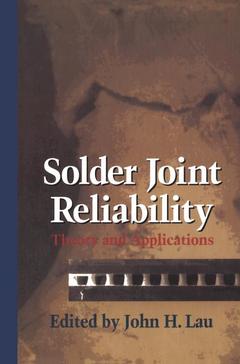Description
Solder Joint Reliability, 1991
Theory and Applications
Author: Lau John H.
Language: English
Subject for Solder Joint Reliability:
Keywords
assembly; circuit; coating; communication; design; electronic circuit; electronics; energy; Hardware; interconnect; laser; material; phase; reliability; telecommunications
Publication date: 02-2014
631 p. · 15.5x23.5 cm · Paperback
631 p. · 15.5x23.5 cm · Paperback
Description
/li>Contents
/li>
Solders have given the designer of modern consumer, commercial, and military electronic systems a remarkable flexibility to interconnect electronic components. The properties of solder have facilitated broad assembly choices that have fueled creative applications to advance technology. Solder is the electrical and me chanical "glue" of electronic assemblies. This pervasive dependency on solder has stimulated new interest in applica tions as well as a more concerted effort to better understand materials properties. We need not look far to see solder being used to interconnect ever finer geo metries. Assembly of micropassive discrete devices that are hardly visible to the unaided eye, of silicon chips directly to ceramic and plastic substrates, and of very fine peripheral leaded packages constitute a few of solder's uses. There has been a marked increase in university research related to solder. New electronic packaging centers stimulate applications, and materials engineering and science departments have demonstrated a new vigor to improve both the materials and our understanding of them. Industrial research and development continues to stimulate new application, and refreshing new packaging ideas are emerging. New handbooks have been published to help both the neophyte and seasoned packaging engineer.
1. Flux Reactions and Solderability.- 2. Solder Paste Technology and Applications.- 3. Technical Considerations in Vapor Phase and Infrared Solder Reflow Processes.- 4. Optimizing the Wave Soldering Process.- 5. Post-Solder Cleaning Considerations.- 6. Scanning Electron Microscopy/Energy Dispersive X-Ray (SEM/EDX) Characterization of Solder—Solderability and Reliability.- 7. The Role of Microstructure in Thermal Fatigue of Pb-Sn Solder Joints.- 8. Microstructure and Mechanical Properties of Solder Alloys.- 9. The Interaction of Creep and Fatigue in Lead-Tin Solders.- 10. Creep and Stress Relaxation in Solder Joints.- 11. Effects of Strain Range, Ramp Time, Hold Time, and Temperature on Isothermal Fatigue Life of Tin-Lead Solder Alloys.- 12. A Damage Integral Methodology for Thermal and Mechanical Fatigue of Solder Joints.- 13. Modern Approaches to Fatigue Life Prediction of SMT Solder Joints.- 14. Predicting Thermal and Mechanical Fatigue Lives from Isothermal Low Cycle Data.- 15. Static and Dynamic Analyses of Surface Mount Component Leads and Solder Joints.- 16. Integrated Matrix Creep: Application to Accelerated Testing and Lifetime Prediction.- 17. Solder Joint Reliability, Accelerated Testing, and Result Evaluation.- 18. Surface Mount Attachment Reliability and Figures of Merit for Design for Reliability.- Authors’ Biographies.
© 2024 LAVOISIER S.A.S.

